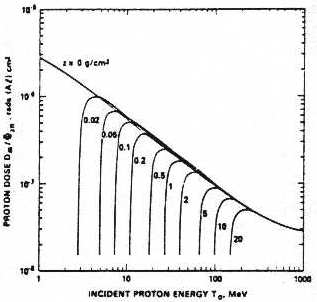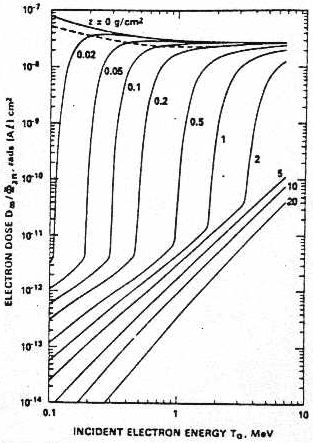
|
| Figure 1. Shielding configurations. |
|---|
| Table of Contents | ECSS | Model Page |
| Background Information | Radiation sources and effects | |
| Ionising dose model SHIELDOSE | ||
SHIELDOSE Calculates, for arbitrary proton and electron incident spectra, the dose absorbed in small volumes of different detector materials for the following aluminium shield geometries:

|
| Figure 1. Shielding configurations. |
|---|
A set of depth-dose distributions for aluminium shields were generated for mono-energetic sources. The distributions were smoothed in depth and incident energy. The overall uncertainty of the final results, including the uncertainties in cross sections used and those due to statistical fluctuations and smoothing of the Monte Carlo data, is estimated to be 10%.
The mono-energetic source results were incorporated into the computer code SHIELDOSE which performs the necessary interpolation and integration for any incident spectrum.
The aluminium dose expressed in rads, as a function of incident energy for fixed depths, is shown for a semi-infinite medium in Fig. 2 for protons (in the straight-ahead approximation, the absorbed dose in a semi-infinite plane medium is equal to the dose at the transmission surface of a plane slab) and in Fig. 3 for electrons.

|
| Figure 2. Proton dose (per unit 2pi isotropic incident fluence) for fixed depth z in a semi-infinite aluminium medium, as a function of incident energy. |
|---|

|
| Figure 3. Electron dose (per unit 2pi isotropic incident fluence) for fixed depth z in a semi-infinite aluminium medium, as a function of incident energy. The dashed curve is the zero-depth dose based only on the stopping power and neglects backscattering from greater depths. |
|---|
Details of the Monte Carlo model and of the cross sections used can be found in Berger and Seltzer [1968a, 1968b, 1970, 1974], along with numerous comparisons with experimental results. The ETRAN bremsstrahlung results, based on the use of a set of empirically corrected Bethe-Heitler bremsstrahlung cross sections, were adjusted to reflect the exact calculations of the bremsstrahlung production cross section of Pratt et al. [1977]. Comparisons , using both the ETRAN and Pratt cross section data sets for aluminium, of the electron mean energy loss per unit pathlength due to the emission of bremsstrahlung and of the total energy radiated in the course of slowing down (in the continuous-slowing-down approximation) give a multiplicative correction factor for the ETRAN results that is very close to unity for electron source energies above 1 MeV, and is equal to 0.96, 0.94, 0.92, 0.89, and 0.82 at 0.5, 0.2, 0.1, 0.05, and 0.02 MeV, respectively.
The proton calculations were done in the straight-ahead, continuous-slowing-down approximation using the stopping power and range data of Barkas and Berger [1964]. Alsmiller et al. [1969] have shown that the neglect of angular deflections and range straggling is negligible in spare-shielding calculations.
Barkas, W. H., and M. J. Berger, NASA Publ. SP-3013, 1964.
Berger, M. J., and S. M. Seltzer, NASA Publ. SP-169, 1968a.
Berger, M. J., and S. M. Seltzer, Computer Code Collection 107, Oak Ridge Shielding Information Center, 1968b.
Berger, M. J., and S. M. Seltzer, Phys. Rev., C2, 621, 1970.
Berger, M. J., and S. M. Seltzer, Nucl. Instr. and Meth., 119, 157, 1974; Seltzer, S. M., National Bureau of Standards Publ. NBS-IR 74457, 1974.
Pratt, R. H., H. K. Tseng, C. M. Lee, and L. Kissel, At. Data and Nucl. Data Tables, 20, 175, 1977.
Seltzer, S. M., SHIELDOSE, A Computer Code for Space-Shielding Radiation Dose Calculations, National Bureau of Standards, NBS Technical Note 1116, U.S. Government Printing Office, Washington, D.C., 1980.
Seltzer, S. M., Electron, Electron-Bremsstrahlung, and Proton Depth-Dose Data for Space-Shielding Applications, IEEE Trans. Nuclear Sci., 26, 4896, 1979.
IEEE Trans. Nucl. Sci., 33, 1292, 1986.
Seltzer, S. M., Updated calculations for routine space-shielding radiation dose estimates: SHIELDOSE-2, NIST Publication NISTIR 5477, Gaithersburg, MD., December 1994.